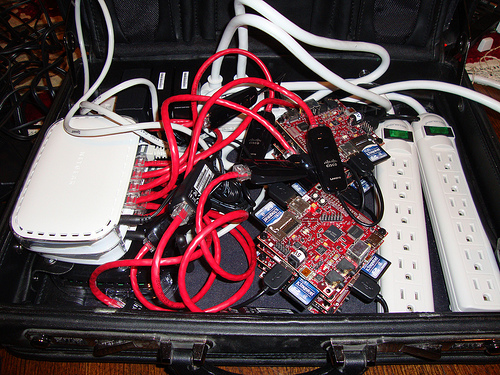
What do you do after you make a BeagleBoard graphing calculator? [Matt] over at Liquidware Antipasto made a BeagleBoard Elastic R Cluster that fits in a briefcase. Ten BeagleBoards, are connected to each other though USB to ethernet adapters and a pair of ethernet switches connected to a wireless router. The cost for this cluster comes in around $2000 and while consuming less than 40 watts of power, out-paces a $4500 laptop. How might you use this cluster? What improvements would you make?[youtube=”http://www.youtube.com/v/dTpgcycBsQU%5D
















I would use it to go to hackaday and add the following comment to every new hack…
1st!
he didn’t show the power usage during the test… wouldn’t it be higher?
Why hubs instead of switches?
What average FPS does it get on Crysis?
manycore isnt simply just a multicore cpu. you actually have to have code that utilizes the several cores like gridgain or sun gridengine with jobs made for them. it only outpaces a laptop with specifically coded jobs to share the work; its not just a regular 10 core computer tranparently
Aero… Oh dear :D
On improvements, I would make a nice rack for them all and do some cable management…
Build a custom PSU for powering the boards, saving space for even MORE (15?) beagleboards. and get a single 16 port switch and mini wireless router (broken airport express, anyone?) also, the option to run straight through ethernet to the network would probably quicken the processing speed a bit. Other than that, good job!
R is largely cpu-bound and badly vectorizable, so it makes sense that using 8 cores instead of 2 speeds up the process, even though the clock speed will be half that of the laptop’s, or even worse.
Its like a beagle boardgy
This doesnt actaully compare to having a faster laptop, does it? Like Aero said: “Crysis?”
How about 100 of them and some hash cracking
“This doesnt actaully compare to having a faster laptop, does it?”
Not as such, no but it is a cluster, like a supercomputer, it should be able to compute problems faster.
Mowcius
How about ONE device that takes this modular idea to the next step.
(PSU, internal cables, i/o switch, router etc) that lets these beagles just “snap n Stack”… after the first one, it would just be connectors.. a lot less wires = a lot less energy…
Observe that the CPU utilization is not pegged when he runs the benchmark on the laptop. I suspect that the improvement results from the random access capabilities of all those flash memory cards.
Also, why all the separate power supplies? I’m up to my ears in 5V logic supplies. Would it be that hard to rig an ATX supply to power the BeagleBoards instead of that rats’ nest of wall warts and outlet strips?
@Aero: Obvious troll is obvious
nice build, tad bit smaller than my old PII cluster ;) Just needs some mounting.
This thing is like a troll cluster. No way could he have made it look that terrible and unorganized unless it was on purpose.
I can’t say this “benchmark” really blows me away either, this thing only finishes the task around 10 seconds faster than his dual-core laptop. Comparing a dual-core laptop with a cluster is hardly a fair fight.
I agree with kristian as well. Why does he appear to actively avoid showing the screen of the power meter during the test? Maybe I am just being overly suspicious, but the way the camera moves makes it seem like he intentionally never points towards the screen, and moves back to the laptop as quickly as possible.
@ yosh:
Take it easy, I was making a joke.
What I would do with this?
Well, for starters, I’d get the DSP’s in alignment over some sort of sync layer .. there’s a *lot* of computing power in those cores that isn’t normally utilized for much more than video decoding, so some sort of ‘math library’ for the DSP’s would be my first order. Perhaps a multi-voice per-BB synthesizer would be in order, or at least a multitimbral sampler with accelerated filters or so ..
Then I’d work on the GUI front-end. Those little SGX’s are deadly in the right context. Dunno how I’d mux ’em, though ..
.. then I’d get a hardware buddy to make it solar-powered.
Add speakers.
And piss off into the bush for a while ..
Aero, I know ;) Sorry if you took my reply the wrong way.
yep that’s a cluster (FK) … what would I do with it? sell it to an art gallery, and call it wire vomit, probably worth more that way
interesting stuff though
me wantee, but not havee $2000 to spare. (wish i did though)
I would make something more beautiful and more profetionnal. Not a bunch of crappy wires like that.
You guys have no imagination.
I would steal GSM calls from foreign dignitaries and use it to hook them up with prostitutes of the opposite gender from whatever they actually ordered.
The perfect computer for traveling on airlines!
I would like to see someone design a more advanced BeagleBoard that could hold 16 ARM processors instead of just the one. I bet you could get 16 of them and the other functionality that the BeagleBoard has under $550. Maybe in a few years we will be able to get such beasts. There are already companies putting together specialized boxes full of GPUs. Maybe the next step is to see how many of these could be crammed into a full sized datacenter rack and how that stacks up against a normal set of servers in both processing power and power usage.
I’d mount them up in the box in a more efficient manner than just tossing them in there… perhaps make the wiring better and add some cooling.
proof of concept doesn’t require mounting, good job
i have got a tube of 144 Atmega168, this give me an idea for a 144 arduinos cluster,
so i can flash my led 144 times faster.
I’d think that while it probably consumes a bit more power, a miniITX-based quad or hex core machine would probably at the worst be comparable to this at a significantly lower cost and complexity. I can’t imagine that six multi-GHz, more advanced cores wouldn’t be able to compete with 10 much slower ARM cores. Shouldn’t be hard to cram it into a suitcase that size either, though cooling might be a bit more difficult.
Also I find it amusing that he points out he’s making the whole thing open source. It already is open source, guy, all you’ve done, as far as I can tell, is strap it together. Can’t copyright an idea, remember…
tim, you obviously do not understand parallelism
I have to post some credit for Mitch Williams and Ron Minnich, who came up with this sort of thing years ago: http://www.linuxjournal.com/article/8177/
Plus, they solved the power and wiring problems nicely.
@john
Now that’s what i was talking about! i couldn’t find the article!
Compliments!!! Especially for the order inside the suitcase.
Extremely cool, but a bit beyond me.
I would likely apply myself to stuff like mounting and streamlining the power situation as noted earlier, but also as noted, it’s not needed for a proof of concept.
(Sometimes the mess has it’s own odd charm too.)
@tim: You could make a systolic array with your atmegas and use it for solving vector math. It probably wouldn’t be terribly useful, but I bet it would earn you top marks as a CS project.
I would put a PBJ sandwich in there in case it gets hungry.
I really hope that laptop doesn’t cost $4500.
I would like to see this done with the Seagate Dockstar. These Gadgets come quite cheap(~20€) and already have an Gbit Ethernet port. Get a bigger Powersource and some Gbit-Switches. For 2000€ one could build a cluster with around 90 nodes.
Someone want to sponsor me :-D
Impressive machines, but I don’t see what they are comparing.
The laptop is running the code and full gui, which eats up a lot more resources than a small kernel.
This sort of test is also biased towards cluster computing.
None the less, its amazing to see that you can use beagle boards in a cluster fashion, hope to see more!
I second the idea of seeing 16+ ARM cpus (I like the idea of 32) on a single board (Almost seems like a home computer replacement at that point), they’re quite cheap, or even a single, newer age board, that could take a ton of P3 era x86 CPUs and do something fun with them, since most people probably have 10 in a box on a shelf (or re-pc has 100…).
FAWN, anyone? http://www.cs.cmu.edu/~fawnproj/
Gen. 1: http://www.cs.cmu.edu/~fawnproj/images/FAWN_cluster1.JPG
Gen. 2:http://www.cs.cmu.edu/~fawnproj/images/FAWN_cluster2.JPG
Gen. 3: http://www.cs.cmu.edu/~fawnproj/images/FAWN_3G.JPG
Gen. 4: http://www.cs.cmu.edu/~fawnproj/images/FAWN_4.JPG
I saw that and was immediately reminded of a project I saw on Pokono: http://www.ponoko.com/showroom/KimberlyTam/strongbox-prototype5-by-kt–4708
A nice case with a whole stack of (what I believe are) Gumstix Stagecoaches ( http://gumstix.com/overview-stagecoach.html ). It seems to me this is a more elegant solution.
You can buy a $1000 laptop with a quad-core processor with hyperthreadding (so 8 cores to linux) and 6GB of memory that will crunch that data in a much smaller time – and it’s easy on power too.
…When I graduated in 2010 my final thesis was excatly this except I had only 2 boards because I needed to buy them myself, in 2009 I had a working prototype and I’m trully glad to see the efforts on this matter have not stopped. I’m not currently working on BB’s anymore..a real shame. But by that time I couldn’t get the DSP to work, it would the next step indeed.
I sent a paper to EDERC 2010 and it should be published by now…can’t seem to find a link if possible I`d like toa ttach it, it is a how-to get a working cluster…
here is a link for my thesis…but it is in portuguese:
http://www.tcc.sc.usp.br/tce/disponiveis/18/182000/tce-09092010-170436/